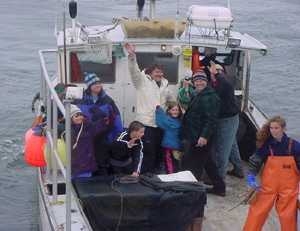This article is adapted from one originally published in the spring 2002 issue of Two if by Sea, a joint newsletter of the MIT and WHOI Sea Grant Programs.
Tim Alley, captain of the 72-foot trawler Bay Flyer, is accustomed to long, rough days at sea. But earlier this year he found himself barraged, not by waves or regulations, but by questions from second-grade students.
The students and Alley are participants in Adopt-a-Boat , an innovative project funded by the Northeast Consortium and coordinated by MIT Sea Grant.
Adopt-A-Boat, which began in fall 2001, partners New England fishermen with educators and their classes. The program uses commercial fishing boats as a vehicle for teaching K-12 students about marine resource utilization, marine ecology and life as a fisherman. Now in its second year, the project is expanding and already includes 30 fishermen and 60 classrooms in the Northeast.
While the concept of stewardship via "adopt-a-something" programs isn't new, Adopt-a-Boat is a bit different, according to MIT Sea Grant education coordinator Brandy Moran. "A lot of those programs are related to a specific location or environment," she said. "This is related to an industry."
Cliff Goudey, MIT Sea Grant's marine advisory leader, added that Adopt-a-Boat is special "because of the depth of support we're prepared to give to make the partnerships work." Along with funds and time, this support has included supplies such as nautical charts for teachers, digital cameras for all fishermen and computers for some, since electronic communication is critical for spanning distances between boats and classes.
Flexibility has proven key to the program. "We work with each teacher to help figure out how Adopt-a-Boat can work with his or her class," said Moran. "Partly this is because we are dealing with such a wide age range."
Partnerships involve visits to classes and vessels as well as regular e-mail exchanges. At Kimball Union Academy in Meriden, N.H., Dean Goodwin's ninth-grade and Advanced Placement environmental students conducted research projects using real-time data telemetered from the Adventurer, Cameron McClellan's trawler out of Portland, Maine. Goodwin and his students have taken part in research cruises with McClellan, gaining hands-on experience with the vessel's technology, equipment and safety procedures.
At Essex Agricultural High School, Amy Holt Cline's 11th-grade students are paired with Nino Randazzo, captain of the F/V Skimmer, out of Gloucester. Cline's students analyzed Randazzo's catch data and made maps showing how permanent and periodic fishing closures, shipping lanes and marine sanctuaries play a role in keeping the Gulf of Maine a sustainable resource. Students are also learning about groundfish biology by raising fish in a 100-gallon recirculating system built by Moran and Goudey. Additionally, the class visits the National Marine Fisheries Services office to better understand the regulations that govern New England fisheries.
Mary Graham, the fourth-grade teacher at Zippel Elementary in Presque Isle, Maine, is communicating with her captain in So. Bristol, Maine each week via e-mail. Using the information from Captain Bruce Morton, her class is presented with math problems. "I have found that the ability of my class to solve math problems has increased since we are solving problems involving 'our captain,'" said Graham.
Eighth-grade teachers Amy Donnelly and J.P. Ware at the O'Maley Middle School in Gloucester, are "hooked" on using Adopt-a-Boat in their classroom. Their students have had several question-and-answer sessions with Capt. Bob Anderson and Capt. Sam Novello to find out about their lives, how weather impacts fishing, and superstitions in the fishing industry. Donnelly and Ware joined Anderson on a fishing trip to document a day in the fisherman's life for their students.
Part of what makes the program work so well, Goudey said, may be the fact that teachers and fishermen have much in common. He pointed out that both professions draw highly committed individuals who often could not conceive of other professions.
"Teaching and fishing both involve oft-repeated tasks, and the outcome is never predictable," he said. And both teachers and fishermen have found that their work environments have grown remarkably more complex with increased regulations.
Visit the Adopt-a-Boat website for more details.
A version of this article appeared in MIT Tech Talk on December 18, 2002.






